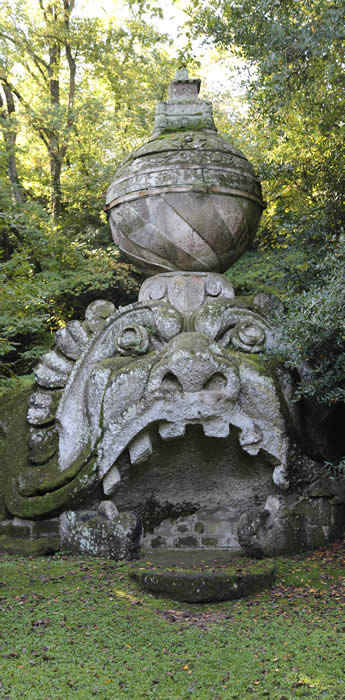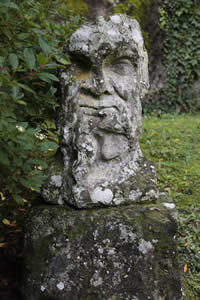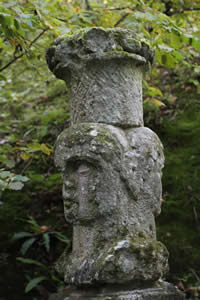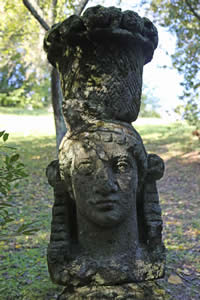|
Parco Dei Mostri: The park of the monsters An extraordinary garden designed by Pier Francesco Orisini, beginning in 1547.
Copyright 2013 by Lee van Laer
Special thanks to Danielle Petrini, who assisted with translations of some of the inscriptions.
Photographs by the author. No portion of this document may be reproduced without permission.
|
A seeming darkness covers the Parco dei Mostri, Pier Francesco Orsini’s arcane masterpiece of Mannerist gardening. Created in the 16th century following the death of his beloved wife, the sculptures seem to emerge from the earth itself as creatures of the underworld—carved, in some cases, from the bedrock itself.
Leave aside for a moment the sheer originality of the sculpture: the idea of carving monumental statuary from the landscape was already a departure from high Renaissance ideals. The concept connects the statuary to a more elemental tradition, entirely appropriate to the Gods, nymphs, sprites and Satyrs of classical tradition. It represents a turning away from the structured idealism of perfect gardens such as the villa Lante (in the immediate vicinity) back towards what may seem to be an earthbound, perhaps even underworldly, aesthetic.
But Orsini was up to more than just a clinical exercise in gardening. Following his capture as a prisoner of war in the 1550s, on his return to his ancestral lands, Orsini entered into a deep state of spiritual questioning- one that caused him to challenge the standard underpinnings of life as it was known, then and now. And the garden is a reflection of that questioning.
The original plan (and surely there was a plan, considering the expense it took to create it) of the garden is lost; and with it, in greater measure, the precise ideas Orsini expressed in his creation. But surely, the garden was far from casual; and enough remains for us to intuit some of his questions, observations, and meanings—although any interpreter of the Parco dei Mostri has to exercise creative impulses nearly equal to those that which birthed the garden in the first place. We cannot for certain know what his intentions were; so we must invent them anew. And Orsini himself demanded this; the garden is a challenge to interpretation, not a lecture on principles, and his welcoming angels, the sphinxes, state the case.
On the way through this garden of earthly delights, we’ll participate in a journey that crosses innumerable lines of demarcation, and discover an epic that spans multiple traditions.
The idea of the cultivated landscape, the external ordering of things, as a reflection of and analogy to the cultivation of the inner self was hardly foreign to the Renassaince tradition—the idea is an ancient one— and classicism, understood as a mythological allegory about development of the soul of man, rotuinely played a central role in gardens.
While the classical references are perhaps evident enough, the surrealistic nature of the Parco dei Mostri touches on territory that defies such facile classification. Attempts to interpret it according to standard modes of thought and tradition are doomed to failure—as Orsini himself knew, and even intended.
The Garden of Earthly Delights, Bosch’s acknowledged masterpiece, was created between 1490 and 1510, and, due both to its extraordinary nature and the extent to which its iconography and style were imitated, had to be well known in art circles by Orsini’s time (he lived from 1523 to 1585.) So we cannot discount a possible influence here; fantastic works of the imagination were increasingly fashionable. The work on the park was begun in 1547; populating a landscape with fantastic creatures was Bosch’s specialty; Orsini took it one step further into the literal, creating an actual landscape populated with the denizens of heaven and hell.
Orsini employed Pirro Ligorio, the master architect and sculptor who designed the waterworks at the Villa d'Este, one of the most famous Renaissance gardens in the area of Rome. He also had a hand in the work at Villa Lante. For a video of an informal walk-through of the waterworks at Villa Lante, click this link. Ligorio, an accomplished architect, antiquarian, and one of the world's earliest experts on seismology, was challenged to create an entirely different kind of garden here; and he certainly did so.
Because he worked directly with local outcrops of stone in situ, it was impossible to lay this park out according to traditional Renaissance principles of garden design, which prize organization, adherence to precise mathematical relationships and combinations, and elaborate symmetry. But then again, Orsini’s intention was to lay out a map of the human unconscious, which displays no such order. Instead of tapping in to the highly ordered world of the Renaissance, of atomistic materialism and literalism, Orsini’s creation is a primordial return to dream worlds and the realm of the collective unconscious.
The parallels between this garden and the work of Carl Jung cannot be denied; the Garden anticipates Jung’s ideas about man’s psyche presenting us with a collected imagery that touches nerves deep inside the human soul, in places that most dare not look in.
Although it’s fairly certain Goya would not have seen this garden, we can also draw parallels between the imagery here and Goya’s later paintings, which likewise enter territory where reason takes a backseat and cryptic giants stalk the landscape. It’s peculiar that Orsini’s vision, which predates Goya by several hundred years, has achieved nowhere near the same fame, even though it often veers into the same imaginative realms. One can easily imagine that Orsini, having seen war, questioned everything man believes about his rationality; and Goya was certainly cut from exactly the same piece of cloth.
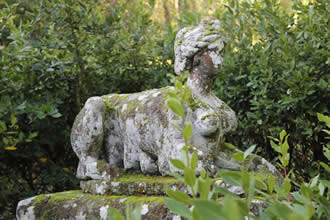 |
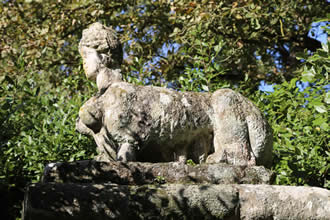 |
Orsini decorated the entrance to his garden with a pair of sphinxes, the classical riddlers of ancient times.
One is inscribed, "He who does not visit this place with raised eyebrows and pursed lips will fail to admire the seven wonders of the world." The other says, "Be very attentive, and tell me if these marvels have come about by mistake, or have been realized according to a form of art."
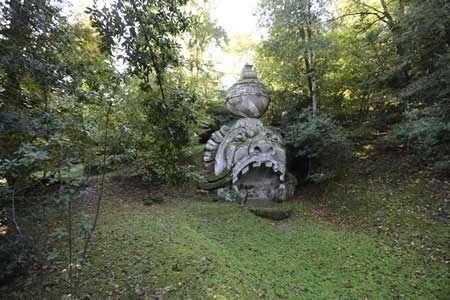
To the left, we encounter the first absolutely extraordinary piece of statuary in the garden. Meant—it is assumed — to represent Proteus, it's a monstrous head, set back against a sylvan hill, opens a gaping maw to swallow everything in its path. It's very reminiscent of the gaping maw in the primary fish of Breughel's "Big fish eat little fish;" and if we are willing to accept the analogy, certainly, we are the little fish.
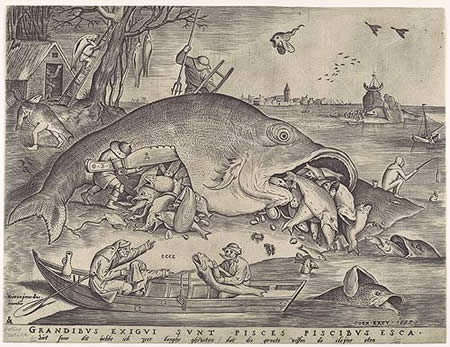
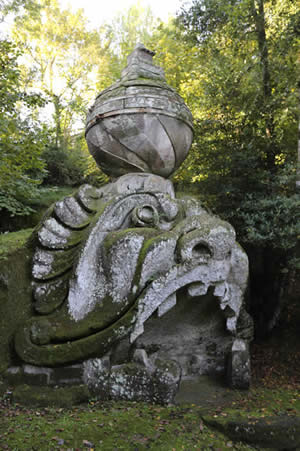 |
Once we intimate this relationship, the frills at the temples of the head and the whiskers that sweep back from the mouth reinforce the idea of an anthropomorphized fish. |
Proteus is believed to have oracular qualities. He is capable of assuming many forms, indicating the constant nature of change. He also represents flexibility, versatility and adaptability —something that will be demanded of the viewer as they walked through the garden. In alchemy, as well as Jungian psychology, he also represents the unconscious. No more apt figure could be chosen to introduce us to the wonders of the garden.
Perched jauntily on the head of this piscine monstrosity, balanced as though this malevolent swallower of all were the very foundation of the world itself, is a globe.
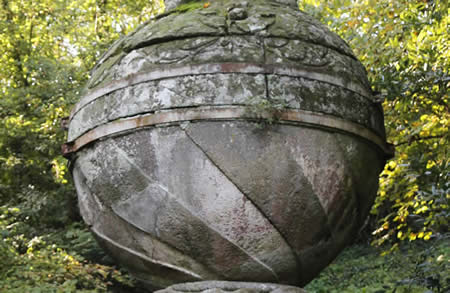
The artist has included spiral elements at the base of the earth, suggesting the rotation of the planet. The reference seems to tell us that the world turns; time passes; and the swallower of all things is time itself, giving us a clue to the identity of the huge head beneath the globe.
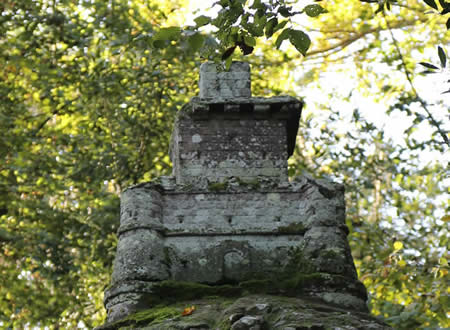
On the globe sits a castle — ostensibly the Orsini castle, suggesting that the Orsini's somehow dominate the world, but the scale of the statuary indicates that this interpretation is badly mistaken. What we have is a tiny castle, sitting on an only slightly larger earth, which is completely supported by the huge, dominant swallower. It puts the works of man in perspective: the largest, most stable and impressive structure human being can imagine, a castle, is dwarfed by the figure of time, ending up as nothing more than a decorative tassel on his cap.
Man, Orsini is arguing, is at the mercy of forces far greater than himself, forces he is unaware of, perched as he is at what he thinks is a lofty position at the top of the dung heap. But the forces of the underworld, the collective unconscious, and time itself, are the unseen darkness that swallows everything we are and dominates the actions that we take. There is far more, he argues, then meets the eye to life; and a high vantage point is not a guarantee that one is seeing everything that must be seen. The biggest things are hidden to us; and this mystery, which lies underneath our very feet themselves is what the rest of the garden will lead us to investigate.
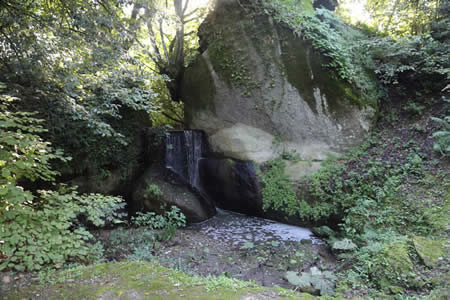
To the left of the swallower, a stream. This carefully engineered water feature, which streams through a naturalistic cleft in the rock—completely unlike the controlled and managed water features at Villa d”Este or Villa Lante, where even the “primordial” sources of water are carefully groomed and mananged—manages to create a spontaneous impression.
man |
Janus, the god of beginnings and transitions |
Woman |
There are a number of important elements in the garden leading up to the figure of Time, the swallower. A man and a woman, representing the ürsprüngliche, or elemental, man and woman, flank the path to the swallower; and in their immediate vicinity we meet a statue of Janus, the two-faced god of beginnings, transitions, and passageways.
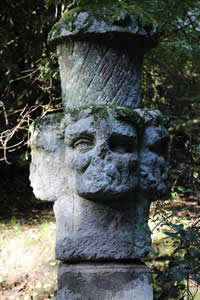
Here we meet, as well, a statue of a god with faces oriented to all four points of the compass. This particular piece of statuary bears a distinct resemblance to the faces at Bayon in Angkor Wat; and we'll see a number of other intriguing pieces that echo this relationship. Remember, traditionally, Brahma has four faces; and given some of the other symbolism and imagery in the garden, one has to wonder whether all the allusions to "world travelers" in the inscriptions are a veiled reference to the influences from asian cultures which appear here in the iconography.
Angkor, one of the world’s pre-eminent temple complexes, not only shares peculiar similarities in some religious iconography; the two culture’s monuments have a strong consonance of appearance in terms of weathering, texture, and even the patterns of lichens on the stone. Any visitor familiar with the landscapes of ancient Cambodian temples will recognize the affinities immediately.
Man and woman, placed in the landscape, simply serve to sound the introductory notes, reminding us that all mythology is, in essence, a reflection of the human character; not the character of the colorful gods, who are used for illustrative purposes. The two-faced god suggests not only beginnings and transitions, but the environment of duality mankind forever dwells within; and the four faced god indicates a need for vision, attention, and vigilance—the ability to see in all directions at once.
Most of these pieces of statuary intentionally recall Etruscan styles, rendering a direct homage to the earliest known inhabitants of this ancient landscape. Orsini held the Etruscans in high regard, and included a number of references to them in the garden, but I believe their presence here is specifically intended to convey an impression of timelessness.
The next piece of statuary we come across is the aptly cthonic Hercules slaying a giant. This piece of statuary is absolutely stunning and completely unexpected, even given the scale and unusual nature of Proteus. If the viewer had any doubt whatsoever as to the extraordinary nature of this garden, it is dispelled when one comes across this particular vignette.
It's difficult to convey the scale of this mid-blowing sculpture without a point of reference, so here you go:
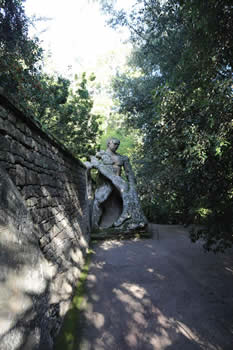 |
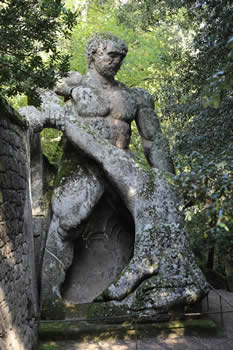 |
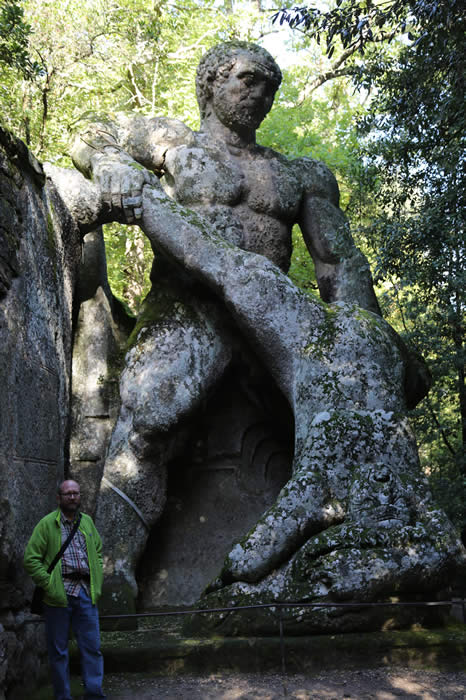
As you can see, the scale is positively staggering. It conveys and overwhelming impression of force and mastery. Coming across it is a truly breathtaking experience.
The image is reminiscent to me of the Hindu incarnation of Vishnu Narasimha, depicted slaying Hiranyakashipu at Banteay Srei.
Serving as an image of the conquering hero mastering evil, it has a hidden message which can perhaps be best understood by looking at the back side of the sculpture.
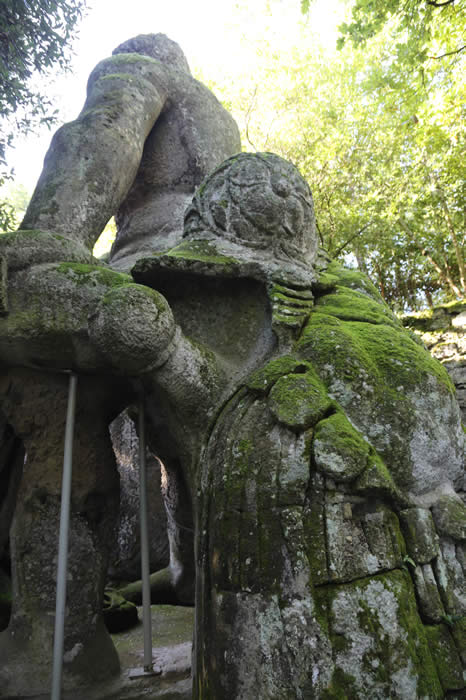
Hercules's sword, shield and helmet are parked at the rear of the action: eschewing the tools of the warrior, he chooses to master his opponent using his bare hands alone. The implication is that the hero uses the force of his physical body and his will alone to conquer. He needs no help from props or artifices; his own inner strength is what prevails. This interpretation is consistent with medieval and later traditions, which assign Hercules the moral imperative of battling monsters which represent amoral forces. Here; the monster is distinctly human; and the inference is that Hercules is battling the inner monsters of mankind—corrupted creatures of the soul—not amoral external forces.
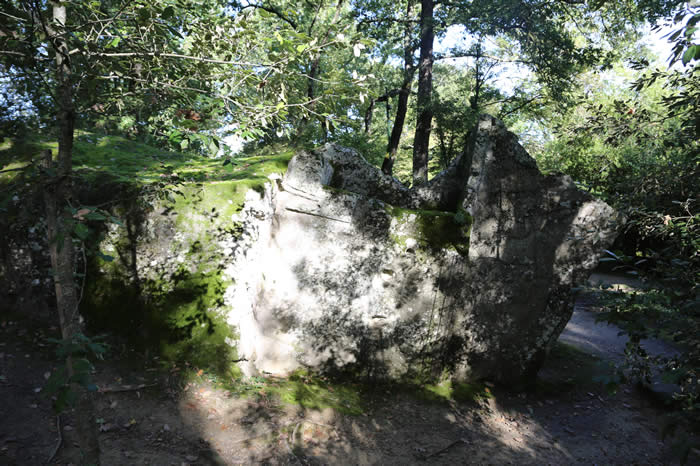
Directly above the subterranean plaza containing the statue of Hercules, we encounter a ruined temple, fallen on its side. The guidebook indicates that the monument is in very bad repair, but i doubt this is the case. the fallen nature of the temple—it has collapsed and is lying on its side—implies that the condition is a function of the position. Here Orsini gives us not stock ennoblement, but an inconclastic vision of the classics: they are fallen over, cast off, worthless. Instead of elevating the classical ideal of perfection, as symbolized by gloriously symmetrical temple structures, Orsini's vision has thrown it over. A new vision must be pursued; this is, at the very least, rebellion. Once again, as at the beginning, our standarized ideas are challenged. The world is falling down; whatever will replace it?
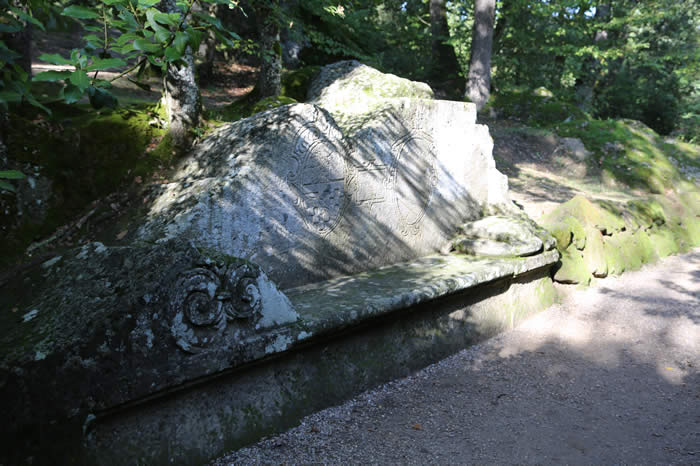
Immediately past the fallen temple, in a position which allows the seater viewer to stare, very counterintuitively, at the back of Hercules's head, is a bench that seems oddly reminiscent of the stone benches the Etruscans placed their dead on. The similarities cannot have been lost on Orsini, who would have been familiar, above all, with the standard architectural features of Etruscan tombs. Is the implication here that rest is only meant for the dead?
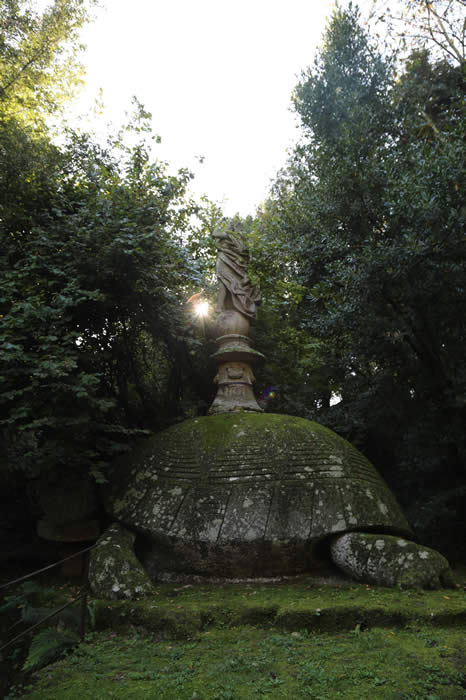
The next Heroic piece of statuary is a giant sacred tortoise, surmounted by a victory figure on the earth. Surely the piece reminds us powerfully of primitive myths that the earth rests on the back of a great turtle; and it equally brings to mind the famous image of Vishnu presiding of the churning of the waters to create the milk of immortality, another famous image from the walls of Angkor Wat.
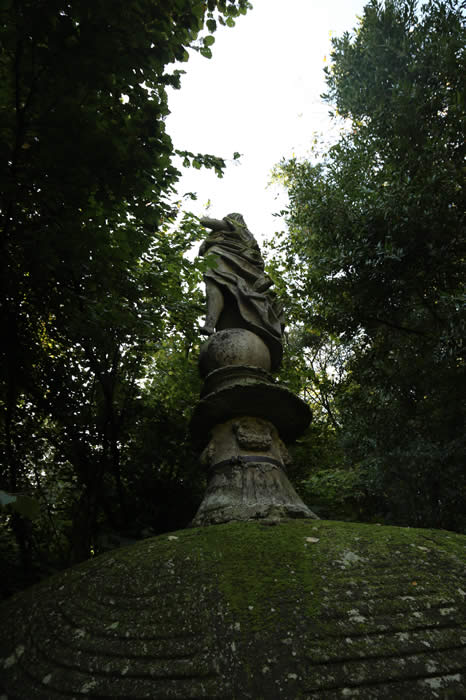
Our image of victory atop the turtle, and indeed the world itself, suggests a kind of moral triumph- perhaps the triumph of Love. Its position on the tortoise suggests the victory is hard won and only achieved through patience and long effort.
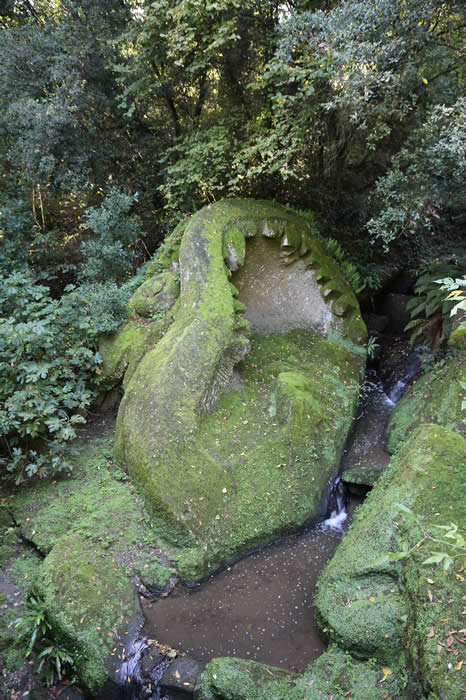
Lurking ominously to the left of the tortoise, a creature of the underworld—kin to our initial friend the swallower—rears up in an attempt to consume the pair.
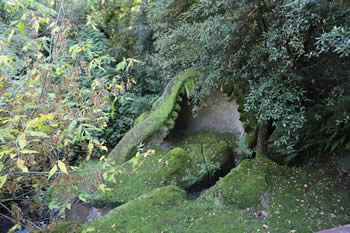
Seen from the perspective of the tortoise itself, the maw is perhaps even more alarming.
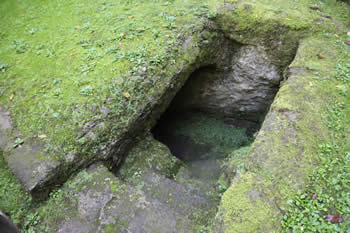
Mysterious steps lead downwards into a hidden crypt. The presence of the underworld, and the unknown, along with the implied threat of missteps and even death, is constant. Even stairways here may lead up from the ground... to nowhere.
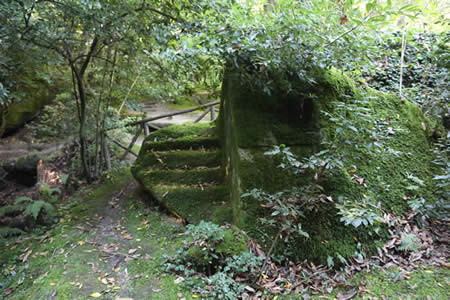
But despite the ominous warnings, the overwhelming impression here is one of triumph.
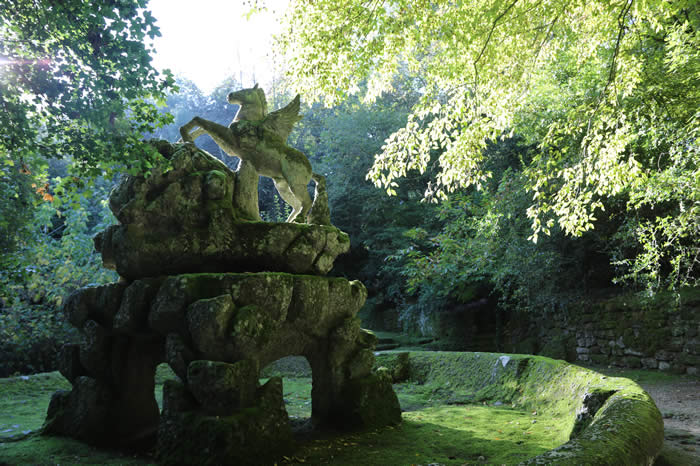
In an image of extraordinary hope, Pegasus takes flight from atop a fountain representing the waters of both life, and the underworld—escape into an unbound world of air.
Leaving the plaza, we're confronted with yet another peculiar reference reminiscent of easter art: a millstone, but a millstone with overtly phallic overtones that reminds us of the Lingam so common in Hindu art.
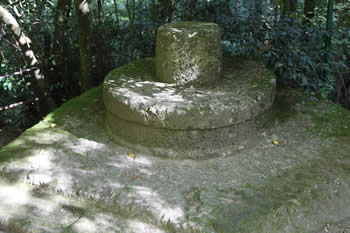
The millstone/phallus probably serves multiple symbolic purposes. One is to indicate that time grinds all of life's efforts into an exceedingly fine flour; the other is to point to the generative powers of destruction and transformation, as symbolized by the grinding power of the stones and the grist they process.
Flanking the phallus, on the other side of the path, is a tree that rises from a recessed hole in the earth.
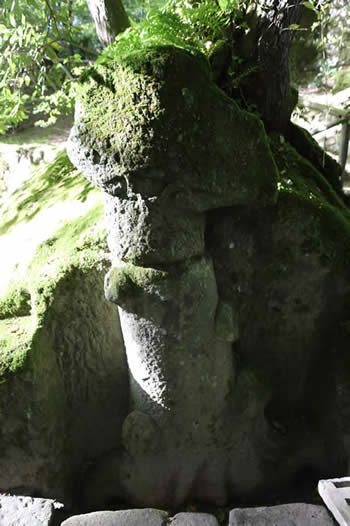
The tree completes a pair of generative phallic indices, this one more exuberantly indicating growth and fecundity.
Click here for a video of the area around the sacred turtle and the Pegasus fountain.
Moving on from the Pegasus fountain, we come across the Nyphaeum and baths, an area once again featuring references to water, but dedicated to femininity and the celebration of womanhood.
The area is flanked by a handsome pair of lions, sadly deteriorated.
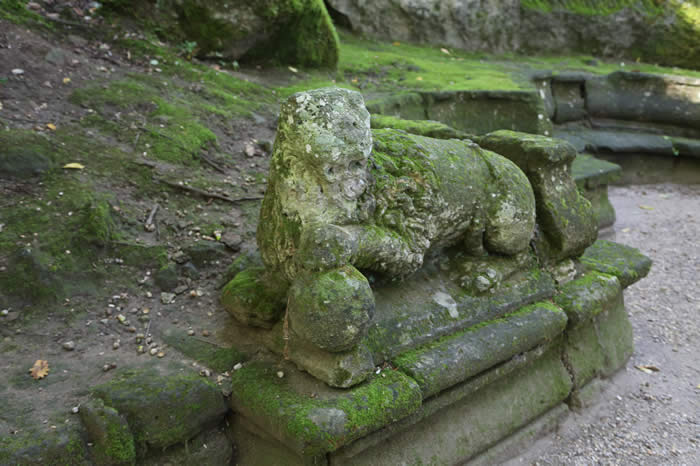
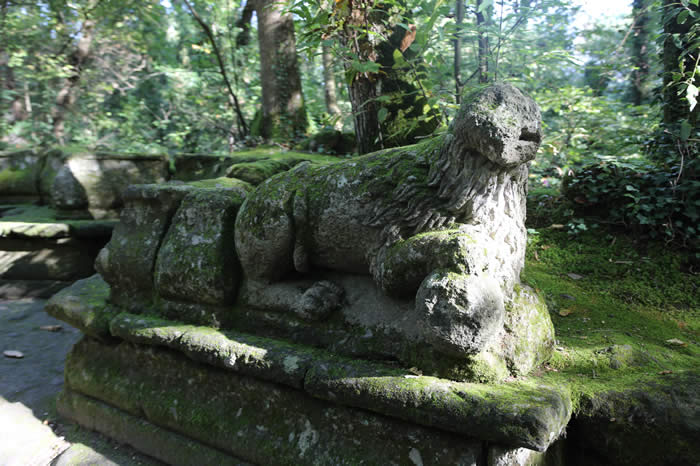
Take note that the lions have balls under their paws, a typical way of rendering lions not only in Renaissance statuary, but also, very typically, in Chinese statuary. Unlike Asian lions, these are prone, not sitting up.
This leads into an extensive area of benches, surrounding an oversized shallow pool, shaped like a bathing tub. It carries subtle inferences of a ritual of cleansing or purification before entering the Nympaheum.
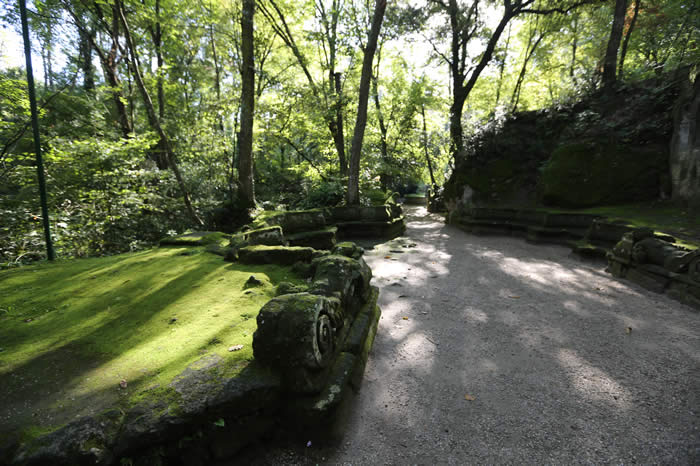
In this shot, we are looking back towards the Pegasus fountain. The benches are on the left and the right, providing ample seating.
For a brief context video of this area of the garden, click this link.
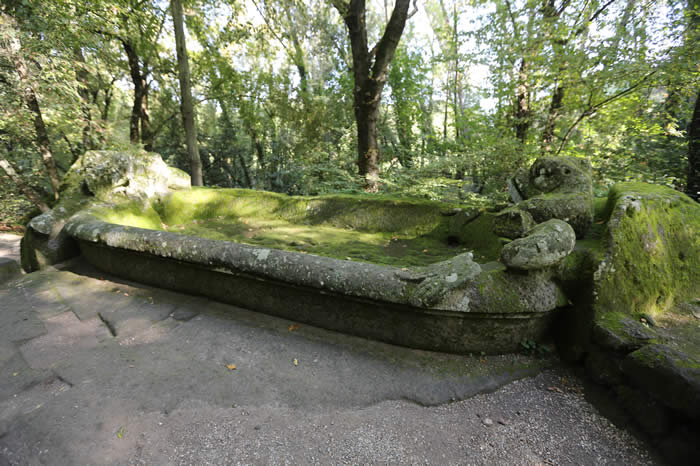
This leads to what appears to be a huge bathing pool, although it is too shallow for the purpose.
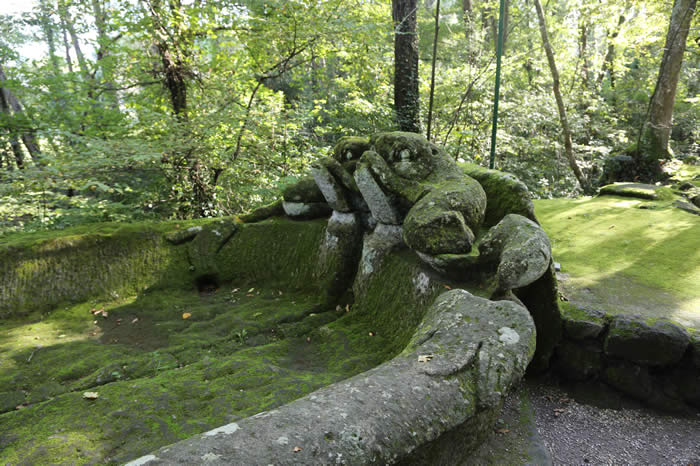
The pool sports two dolphins; it's a fair guess that they used to spout water.
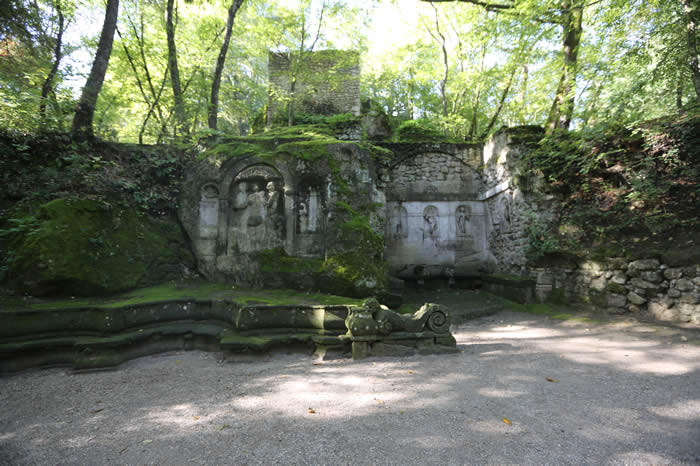
The adjacent Nymphaeum, seen in its entirety. To the left, a vignette of the three graces; to the right, the muses (?) seasons, and the hours. Most of this statuary is so deteriorated that it's difficult to be clear on the meaning without some help.
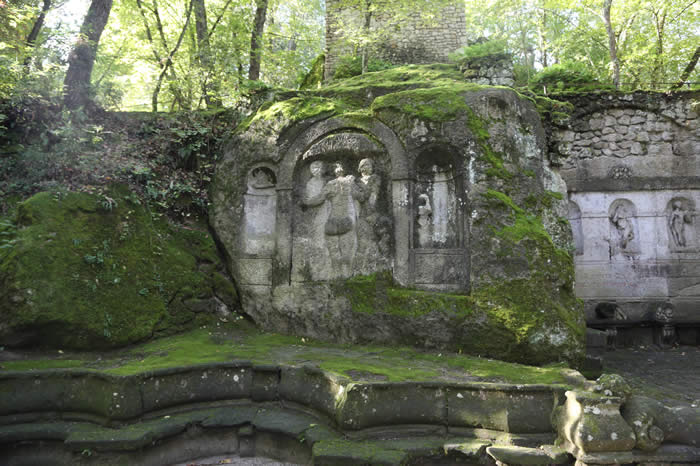
The figures to the left definitely appear to represent the three graces. Flanking niches have lost their statuary; we can only guess what may have been there.
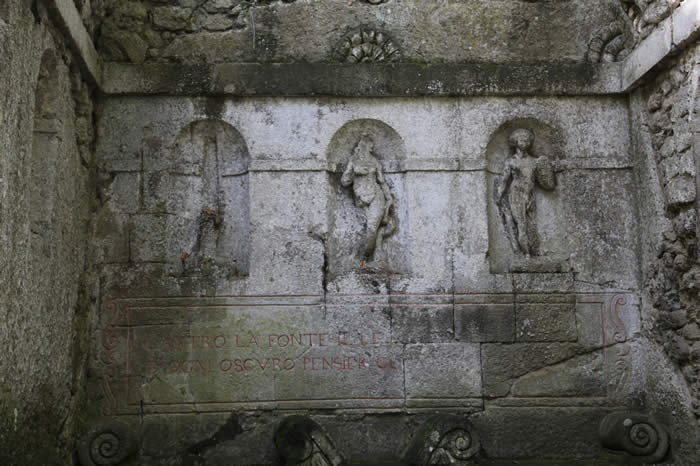
A close-up of the area to the right.
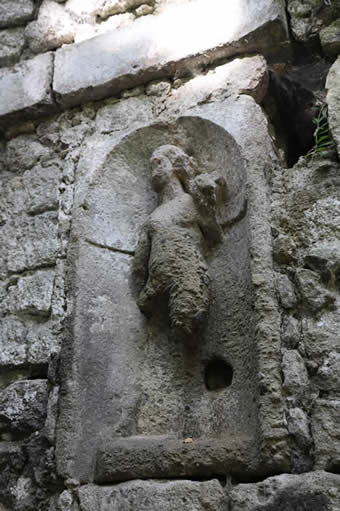 |
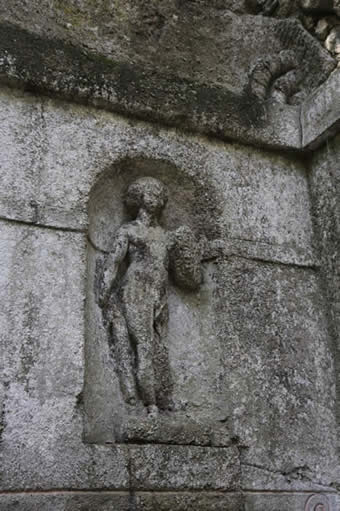 |
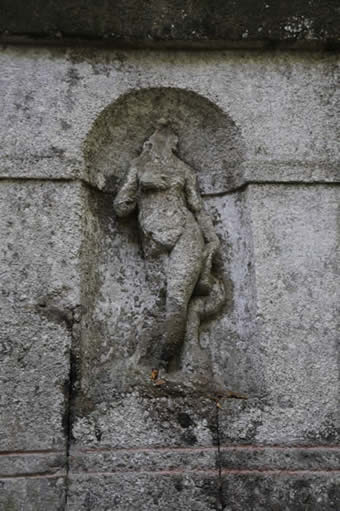 |
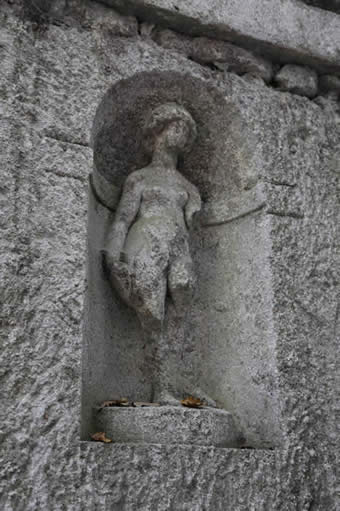 |
Four of the five nymphs in the right area. The fifth one is destroyed and the niche is empty.
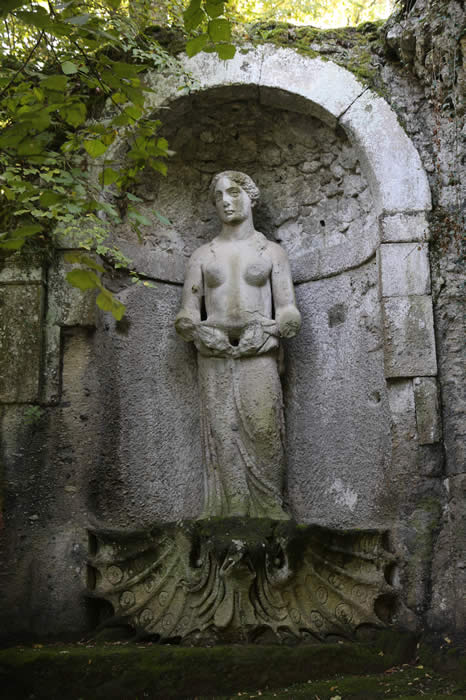
The fine statue of Venus—serene and distinctly Etruscan in nature—which follows the nymphaeum gives us a hint of the quality the original nymphs must have displayed. Standing not on a seashell, but on a dragon, she presents as with an offering—perhaps a bouquet of roses, her signature flower—whose exact nature is lost to history. Orsini labeled this Venus a "virile" Venus, implying an aggressive fecundity. Jupiter watches over her; The overwhelming message is one of the sheer power of love and sexuality in the earthly realm. However, given Orsini's interest in the Etruscans and the distinctly water- based themes surrounding both this area and the whole of the garden itself, we can surmise that his venus represents Venus Cloacina, Venus the purifier,a hybridization of the Etruscan water goddess Cloacina.
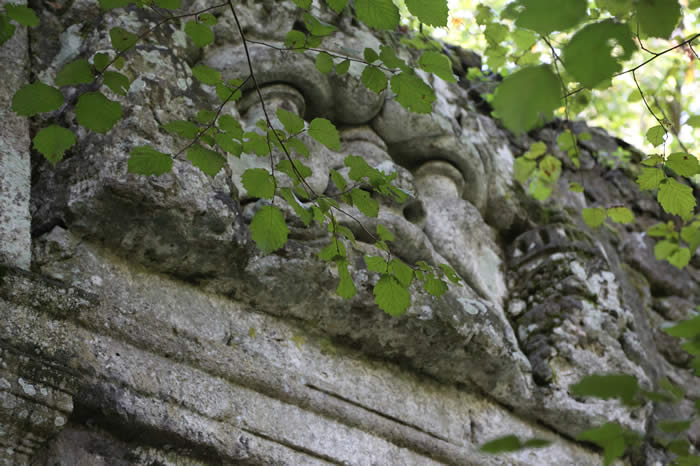
Jupiter (Venus is located directly to the right.)
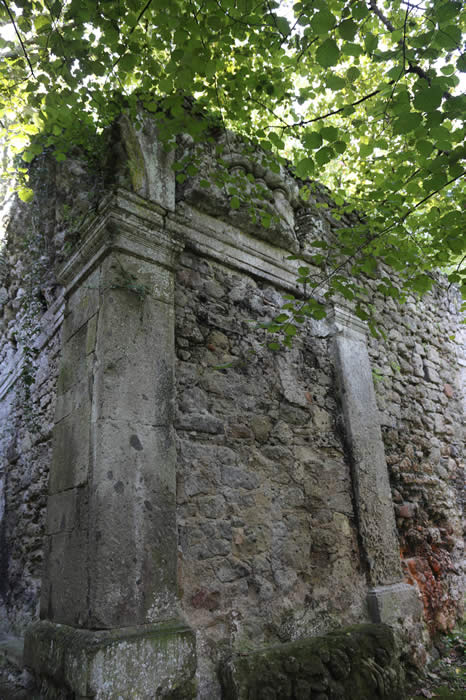
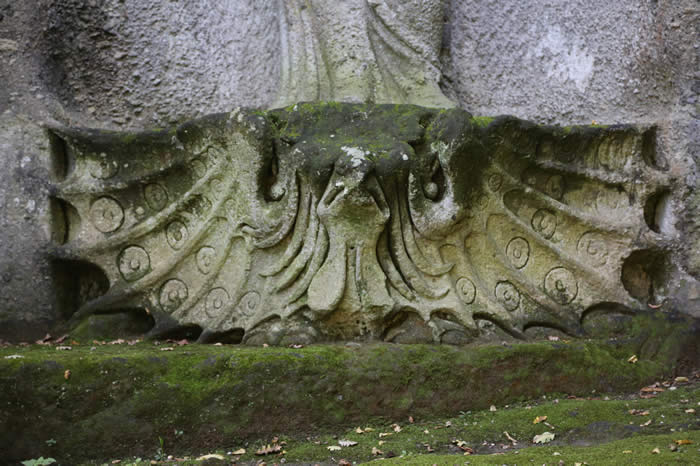
The dragon pedestal. Take note this is a distincly piscine dragon.
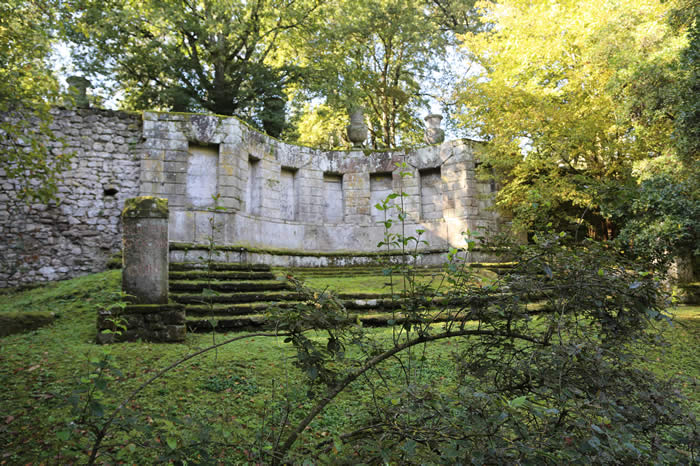
The theater, directly to the right of Venus. Statuary from its six niches, if there ever was any (see below) is long gone. A typical feature of Roman gardens, but in this case, one with a more specific—rather than general—allegorical purpose in mind. We gather the impression that this stage is set for—and presided over— by love (Venus) but that it's now empty- a fitting and quite perfect juxtaposition following the death of Orsini's wife. The niches for statuary may have been left intentionally empty in order to emphasize the isolation implied by the unoccupied stage.
Underscoring this impression, the theater is flanked by two obelisks with a touching inscription that highlights his spiritual anguish.
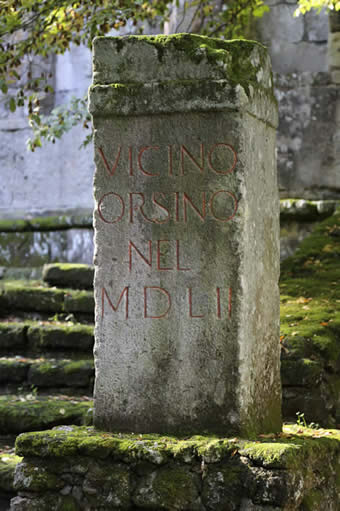 |
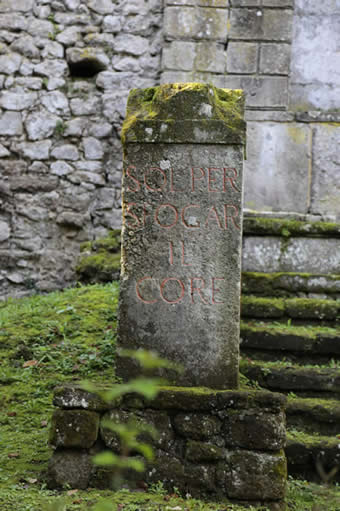 |
"Vicino Orsini in 1552" |
" Only to relieve his soul" |
Moving on, we come to another daring feature which defies precedent in comparable gardens of its time. The leaning house, implying a subversion and disruption of stability, the immanent collapse of everything predictable and reliable, looms over the transition to the next levl of the garden; and one must pass through this disturbingly altered landscape in order to go forward. It's as though orisni wnated to reproduce a physical sensation analogous to the death of his wife: a radical reformation of the landscape.
The reformation is not only visual, that is, intellectual; moving through the house we physically experience vertigo and disorientation, meant to mimic the emotive force of bereavement, thus creating an emotional state of transformation that brings us, for a moment, into active relationship with a taste of Orsini's state of grief and questioning.
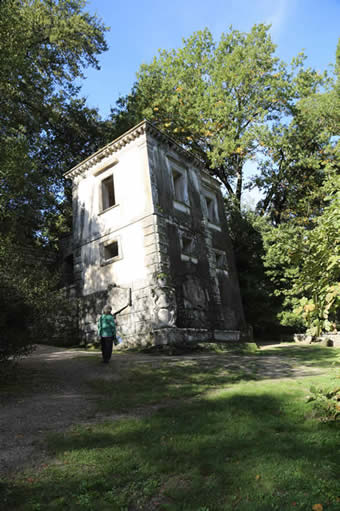 |
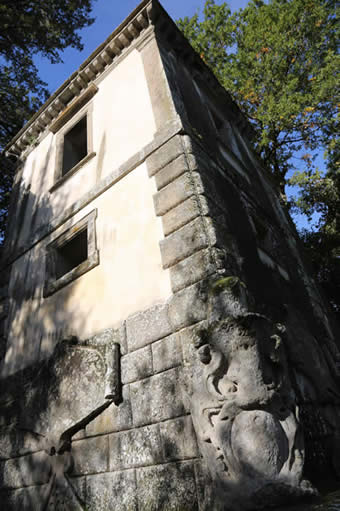 |
The leaning house |
A vertiginous experience! |
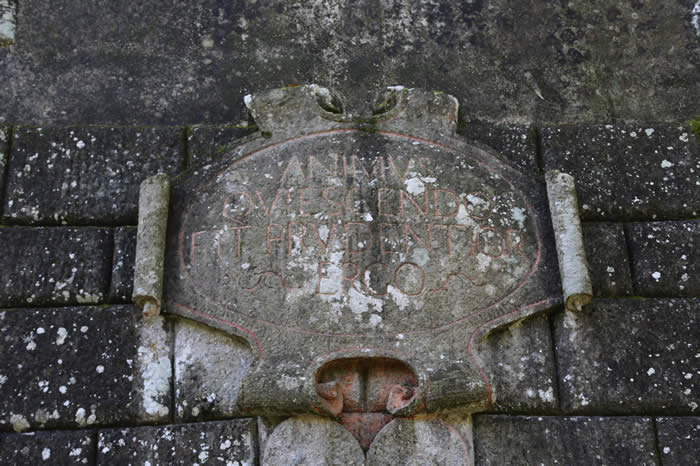
The inscription on the house reads, "Animus quiescendo fit prudentior ergo"
—
"By virtue of stillness, spirit becomes wiser."
We are called here, to a moment where we stop. A moment where the house tilts; a moment where we are out of our element, and our expectations are confounded. The theater is empty, with no love to fill it; the house is empty, and its floors are not level. We must stop; because we do not know this world. It has none of the things we're familiar with in it.
Yet in stopping, our soul sees itself, and we grow.
Can Orsini truly have been alluding to such esoteric secrets? Certainly, he gave us an esoteric garden; and he was a troubled man who had done a great deal of thinking about what life means, that much is evident. Even more evident is the fact that he was unique, and willing to express himself in ways that defy convention. All of these elements suggests that he was a man who expend a great deal of time pondering his life, and who made decisions that belonged to him and himself alone. So all of the qualifications for an original thinker, an inner philosopher, are definitely on the table; and here, if you will, is a call to silence — a call where, confronted with the impossible, we stop, and we contemplate.
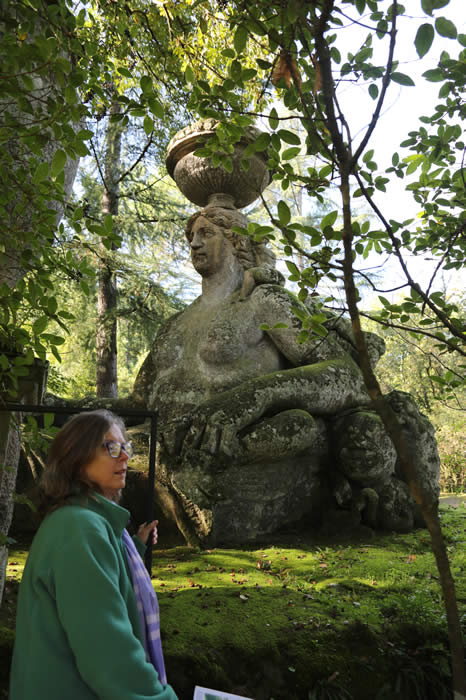
Moving on, we come to Ceres, goddess of agriculture. By way of cultivation, she performs a dual function here, indicating cultivation of not just gardens and the harvest, but also the inner self.
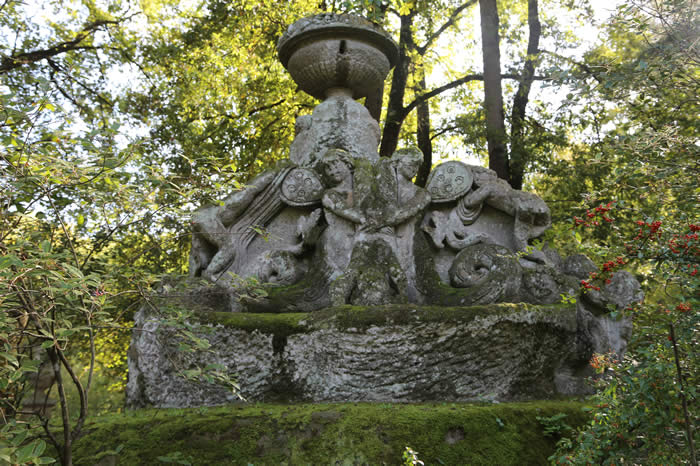
Playful children surround her; but the upside-down figure in the center is disturbingly reminiscent of Hercules and his vanquished opponent.
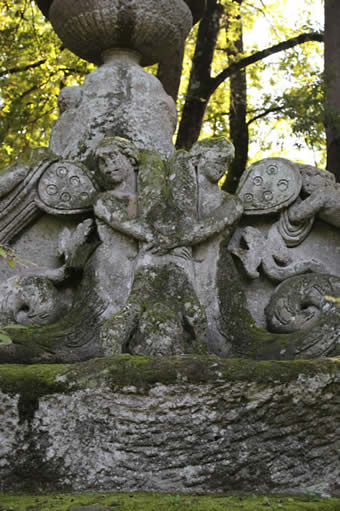 |
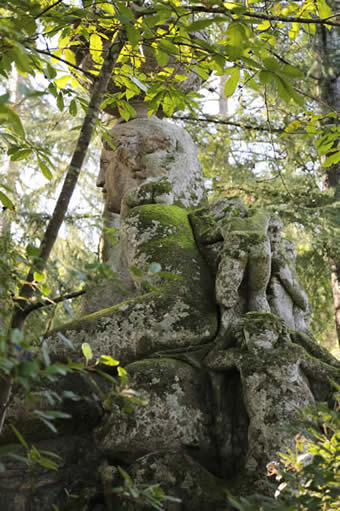 |
All material copyright 2013 by Lee van Laer
Photographs by the author. No portion of this essay may be reproduced without permission.
For permissions, the author may be contacted at Doremishock@gmail.com
